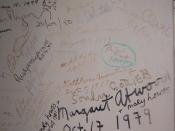Tricks With Mirrors
by Margaret Atwood
In Part I of Tricks With Mirrors, Atwood uses a seemingly vague introduction to the subject matter, but gets straight to the point. Within five lines, she distinctly identifies her role as a mirror as she says, "I enter with you and become a mirror," (4-5). She gives the impression that she is merely an object in this relationship. She is a mirror through which her self-absorbed lover may view himself. "Mirrors are the perfect lovers," she states (6-7). They show a constant and loyal reflection to whoever may stand in front of them. She is objectifying herself as she tells her lover to carry her carefully up the stairs and to throw her on the bed with her "reflecting side up" (line 12). She then moves on to describe the patterns of their intimacy in an almost detached manner - her lover does not kiss her; he only kisses his own reflection. She is only a mirror, after all. The speaker tells us that her lover is blind, whether willingly or not is not identified to the truth of their relationship when she says that, during their intimate moments, "your own eyes you find you are up against closed," (16-17). She speaks with a bitter tone, clearly showing that she is displeased with her situation and the constant expectations she must meet. At the same time, though, she writes with an open-handed honesty. She is simply a mirror telling her story, it seems. The introduction that Part I provides us with, identifies the problem the speaker is facing, she is at once unhappy but has willingly placed herself in her role as a mirror.
In the second part of Atwood's poem, the speaker describes the undeniable feelings that come from being a...


